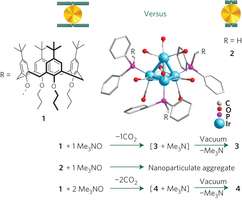Scientists demonstrate improved catalyst control, energy savings could result

(Phys.org) —Inspired by how enzymes work in nature's biological processes, researchers have demonstrated a way to improve control of synthetic catalysts, according to a paper co-authored by a University of Alabama computational chemist that was published in a recent online issue of the journal Nature Nanotechnology.
"This work is an exciting example of how we are learning to improve control of chemical reactions at the level of a single atom," said Dr. David Dixon, the Robert Ramsay Chair of Chemistry at The University of Alabama.
Catalysts accelerate chemical reactions so that they go faster and use less energy. Estimates indicate that the economic impact of catalytic processing, including pollution abatement, is $10 trillion annually, Dixon said.
The UA researcher cited improving the conversion of biomass – typically plant-based materials – into transportation fuels as an example of how designing more efficient catalysts could benefit society.
The paper, titled "Selective molecular recognition by nanoscale environments in a supported iridium cluster catalyst," was published in the journal's online edition April 20.
In the research, sponsored by the U.S. Department of Energy, the scientists showed how to switch molecular bonding – the interaction that holds assemblies of atoms together – off and on at will at specific locations within the catalyst. The discovery, researchers said, has potentially profound implications for chemical conversions involving metal catalysts.
The research team included Drs. Alex Katz, of the University of California, Berkeley, and Bruce Gates, of the University of California, Davis. Shengjie Zhang, one of Dixon's graduate students, served a leading role in the computational effort of the article, and Dr. Alexander Okrut from the Katz laboratory led the experimental effort.
"This will help us to design better catalysts that use less energy and produce valuable products with less wasteful by-products," Dixon said.
"In enzymes, nature's catalysts, the switching of site reactivity steers fruitful conversions while excluding others entirely," Katz said. "Such switching at an active metal site permits enzymes to function in water, for example, among many other feats that include being the world's fastest and most selective catalysts, which are used to sustain life. Now, we are able to achieve similar switching in man-made catalysts as well."
"This offers," Gates added, "the promise of greener and cheaper catalyzed industrial processes – by doing what nature does so well, except now doing this in man-made systems."
More information: "Selective molecular recognition by nanoscale environments in a supported iridium cluster catalyst." Alexander Okrut, et al. Nature Nanotechnology (2014) DOI: 10.1038/nnano.2014.72. Received 29 July 2013 Accepted 12 March 2014 Published online 20 April 2014
Journal information: Nature Nanotechnology
Provided by University of Alabama in Tuscaloosa



















